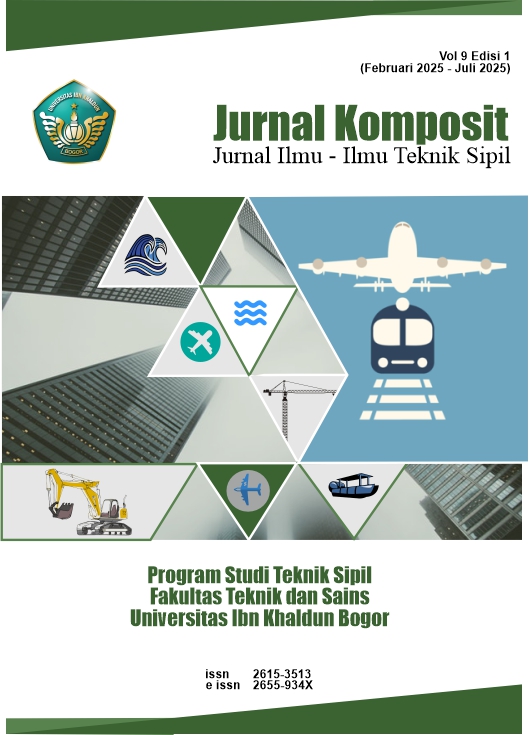Analisis Tingkat Kebutuhan Pekerja Level Menengah Proyek Konstruksi (Studi Kasus: 3 Proyek Gedung di Jakarta Barat)
DOI:
https://doi.org/10.32832/komposit.v9i1.16135Keywords:
Teori kebutuhan Abraham Maslow, tingkat kebutuhan, , pekerja tingkat menengahAbstract
The motivation of the workers influences the results of project work. The cause can be identified by knowing the level of needs of the workers. One way to find out the level of needs of workers is with Abraham Maslow's theory of needs. Abraham Maslow's ranking of needs consists of 5 levels of basic human needs, sequentially from the lowest level, namely physiological needs, safety, love and affection, esteem, and self-actualization. This study aims to analyze the level of needs for mid-level construction workers at Building Project in West Jakarta which affects the motivation of construction project workers. The research method used is a questionnaire to middle-level workers from three project. Data processing and literature analysis were carried out when the questionnaire indicators based on the literature were obtained on the 5 needs ratings. The results obtained from the questionnaire are that the most influential need factors for middle-level workers are support from family to workers, bonuses, good health programs, relations between co-workers, and overtime pay increased. By improving communication on the factors of need for support from family and good relations between co-workers, rewards on the factors of bonuses and overtime pay, last is guarantees a good health program on the factors of the work environment
References
Andi, A., & Djendoko, D. (2004). Motivasi Pekerja pada Beberapa Proyek Konstruksi di Surabaya. Civil Engineering Dimension, 6(2), pp.80-87. https://doi.org/https://doi.org/10.9744/ced.6.2.pp.%2080-87
Anggraeni, C., Agrina, A., & Hasanah, O. (2020). Hubungan Dukungan Keluarga terhadap Motivasi Kerja Kader Posyandu [Universitas Riau]. In Repository Universitas Riau. http://repository.unri.ac.id:80/handle/123456789/4085
Aziz, H., & Hidayat, B. (2017). Motivasi Pekerja pada Proyek Konstruksi di Kota Padang. Jurnal Rekayasa Sipil (JRS-Unand), 13(1), 29. https://doi.org/10.25077/jrs.13.1.29-42.2017
Barg, J. E., Ruparathna, R., Mendis, D., & Hewage, K. N. (2014). Motivating Workers in Construction. Journal of Construction Engineering, 2014(12), 1–11. https://doi.org/10.1155/2014/703084
Damayanti, R., Nurlaela, & Usman, S. (2019). Pengaruh Keselamatan Kerja dan Kesehatan Kerja terhadap Kinerja Karyawan PT Pulau Lemon Manokwari. Fakultas Ekonomi Dan Bisnis, Universitas Papua, 351–365. https://jurnal.unej.ac.id/index.php/prosiding/article/view/9565/6333
Faustine, C., & Waty, M. (2022). Peringkat Faktor-Faktor yang Mempengaruhi Produktivitas Tenaga Kerja pada Proyek Konstruksi. JMTS: Jurnal Mitra Teknik Sipil, 5(3), 681–694. https://tinyurl.com/cfaustine
Hidayat, F. (2009). Motivasi pekerja pada proyek konstruksi di Kota Bandung. Media Teknik Sipil Universitas Kristen Petra, 9(1), 151871. https://www.neliti.com/publications/151871/motivasi-pekerja-pada-proyek-konstruksi-di-kota-bandung
Lianto, I. E., & Anondho, B. (2018). Analisis Besaran Koefisien Ketidakpastian Environmental Uncertainty (EU) yang Berpengaruh pada Perhitungan Buffer pada Critical Chain Project Management (CCPM) di Jakarta. JMTS: Jurnal Mitra Teknik Sipil, 1(2), 143. https://doi.org/10.24912/jmts.v1i2.2671
Mangare, J., Sompie, B., & Tarore, H. (2012). Kajian Proporsional Model Sumber Daya pada Proyek Konstruksi Gedung. Jurnal Ilmiah Media Engineering, 2(3), 98640. https://ejournal.unsrat.ac.id/index.php/jime/article/view/4240
Maslow, A. H. (1943). A Theory of Human Motivation. Psychological Review, 50(4), 370–396. https://doi.org/https://doi.org/10.1037/h0054346
Oglesby, C. H., Parker, H. W., & Howell, G. A. (1989). Productivity Improvement in Construction. McGraw-Hill. https://www.worldcat.org/title/productivity-improvement-in-construction/oclc/581334273
Sampurno, B., Sumadi, S., & Herlambang, T. (2020). Pengaruh Gaji, Tunjangan, dan Bonus Terhadap Motivasi Kerja dan Kinerja Karyawan PT. BPD Jawa Timur Jember. Jurnal Sains Manajemen Dan Bisnis Indonesia, 10(2), 194–205. https://doi.org/https://doi.org/10.32528/jsmbi.v10i2.4114
Setiawan, N. (2017). Penentuan Ukuran Sampel Memakai Rumus Slovin dan Tabel Krejcie - Morgan: Telaah Konsep dan Aplikasinya. Diskusi Ilmiah Jurusan Sosial Ekonomi Fakultas Peternakan UNPAD, November, 1–16.
Willy, Y., & Sekarsari, J. (2020). Analisis Aspek Sumber Daya Manusia terhadap Kinerja Pekerja Proyek Konstruksi. JMTS: Jurnal Mitra Teknik Sipil, 3(3), 523. https://doi.org/10.24912/jmts.v3i3.8392
Wong, P. T., & Low, A. (2018). Improving Workplace Productivity: Applications of Maslow’s Need Theory and Locke’s Goal-Setting. Psychology & Psychological Research International Journal, 3(8). https://doi.org/10.23880/pprij-16000189
Downloads
Published
How to Cite
Issue
Section
License
Copyright (c) 2025 Jurnal Komposit: Jurnal Ilmu-ilmu Teknik Sipil

This work is licensed under a Creative Commons Attribution-NonCommercial-ShareAlike 4.0 International License.
Authors who publish with this journal agree to the following terms (Penulis yang mengajukan publikasi artikel telah menyetujui hal berikut):
- Through this publication, the author agree to submit the copyright of article writing to Jurnal Komposit: Jurnal Ilmu-ilmu Teknik Sipil. This copyright submission takes the form of, but is not limited to: reproduction of the article and parts therein, including photographic reproductions; distribution of articles through printed and electronic documents; and translation of articles(Bahwa melalui publikasi ini, hak cipta penulisan artikel diserahkan kepada Jurnal Komposit: Jurnal Ilmu-ilmu Teknik Sipil. Penyerahan hak cipta ini berupa, namun tidak terbatas pada: perbanyakan artikel dan bagian di dalamnya, termasuk reproduksi fotografi; penyebarluasan artikel melalui dokumen cetak dan elektronik; serta penterjemahan artikel).
- The authors agree to the terms of the Copyright Notice, according to Creative Commons Attribution-NonCommercial-ShareAlike 4.0 International License., which will apply to this article if and when it is published by Jurnal Komposit: Jurnal Ilmu-ilmu Teknik Sipil. (Para penulis setuju dengan ketentuan Pemberitahuan Hak Cipta, sesuai dengan Lisensi Internasional Creative Commons Attribution-NonCommercial-ShareAlike 4.0., yang akan berlaku untuk artikel ini jika dan ketika diterbitkan oleh Jurnal Komposit: Jurnal Ilmu-ilmu Teknik Sipil).

This work is licensed under a Creative Commons Attribution-NonCommercial-ShareAlike 4.0 International License.



.png)










